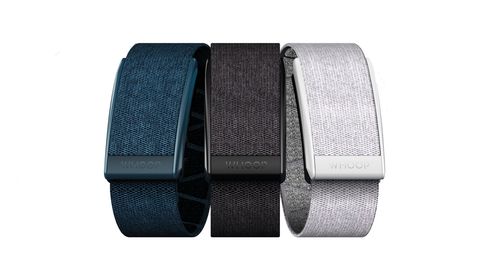YOU MAY HAVE SEEN Whoop, the fitness monitor that looks like part concert wristband, part tracking device. NFL, UFC, and NBA athletes (and the CrossFit guy in IT) are all wearing them, hoping data can be their competitive advantage. “Whoop collects about 1,000 to 10,000 times as much data as your average smartwatch,” says Whoop founder and CEO Will Ahmed.
The device has evolved over the past few years it has been on the market, and the current version, the Strap 3.0, is one of our favorite health tracking wearables and a top choice for performance-minded athletes and weekend warriors alike. With a solid battery, engaging app, and useful sharing features you can use for humblebrags and stunt posts on social media, the Whoop is the perfect companion for the current (and future) moment in fitness.

But for the Whoop to be useful the data it collects is the most important factor. The strap tracks biometrics like resting heart rate and heart-rate variability (HRV). And it’s working. People who have used Whoop for a year see those metrics improve, according to Ahmed.
Here are the numbers you should monitor in the future.
HRV: 25–105
Scientists have been interested in HRV since the 1960s. HRV is a measure of the variation in the time between your heartbeats. More variability means you’re ready to ham-mer in the gym. Less? You may be burned out. Watch trends, too: Improvement over time means you’re getting fitter. The average for a 25-year-old Whoop user is 78. For a 55-year-old, it’s 44.
RESPIRATORY RATE: 12–20
As COVID-19 swept across the country, Whoop tweaked its recovery algorithm to stress the importance of respiratory rate, the average number of breaths you take per minute. Changes in this number may suggest you have a COVID-19 infection before you experience any symptoms, according to an Australian study.
RECOVERY: 0–100%
Ten thousand data points is a lot of data points. So Whoop puts them all into a simple daily recovery percentage, highlighted in red (33 percent or below), yellow (34 to 66 percent), or green (67 percent or above). Whoop’s next phase is to go outside the body and allow people to input all their lifestyle choices, like nutrition, meditation, and prescription use, to shed light on how habits impact health and readiness.
STRAIN: 0–21
Everything you face—your workout, a deadline, a long walk—puts strain on your body and heart. Whoop tracks all this in Strain. You get a personalized target range each day (10 to 17, for instance). Going below optimal strain aids recovery; hitting it can build fitness. It’s also a good way to gauge whether that “hard workout” was truly hard.
A version of this story originally appears in the March 2021 issue of Men’s Health, with the title “USING DEEP DATA TO GET YOU IN BETTER SHAPE“.
Source: Read Full Article
